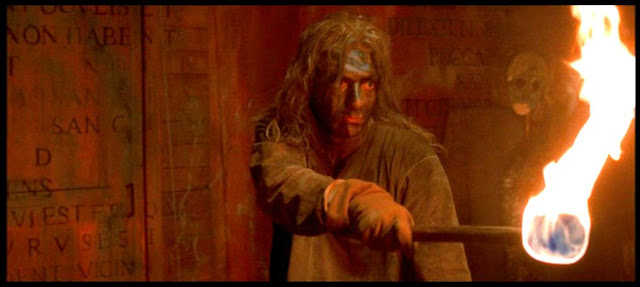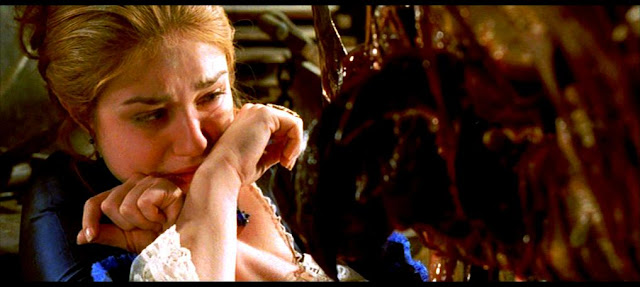
In initial viewings, Christophe Gans’ loopy, imaginative mixture of horror film, swashbuckler, chop-socky flick and conspiracy thriller, struck me as over-long and frustratingly pieced together. In returning to it, I found it has aged well, and even if it still lacks contiguity in reconciling some wildly disparate story and cinematic elements, it’s nonetheless always been admirable for its originality and scope, and the quirkier conceits and leisurely pace now seem minor faults. Taking a different tack to the same problem of reinventing French popular filmmaking than the House of Besson, Gans took similar obsessions – martial arts, pulse-racing action, socio-politico cynicism and multicultural idealism – and cross-bred it with the familiar form of the historical film, leaving intact a certain level of intellectualism in that genre even whilst offering up kung-fu fighting Indians and steampunk monsters.

Distinguished especially by Dan Laustsen’s brilliant photography, Brotherhood offers up Hammer Horror forests and ruins, well-handled CGI and animatronic monstrosities, and ebullient high-kicking physical violence, as it riffs on the real-life mystery of the Beast of Gévaudan, where mysterious wolf-like creatures terrorised rural France in the 1760s. Royal naturalist Grégoire de Fronsac (Samuel Le Bihan) and his blood-brother Mohawk offsider Mani (Mark Dacascos), survivors of the Seven Years War, are sent to investigate the beast’s relentless rampage, embodying between the two of them the gamut of the Voltaire-Rousseau Enlightenment’s ideals – Noble Savage and Rational Man team up to kick more ass than Batman and Robin.

They soon find their efforts squeezed between the frosty, close-ranked demeanour of the local aristocrats, led particularly by the powerful Morangias family and priest Sardis

For the attacks of the beast, a mysterious wild animal wearing a metallic suit that makes it all the more deadly with steel teeth and armour plating, are directed by a hidden mastermind, linked to a plot to frighten the populace, roll back liberal reform, and reinforce religious and aristocratic hegemony! Bloody battles with the steel-bristled beast, vendetta-fuelled combat with the hidden cabal’s feral Gypsy army, incestuous rapes, burial alive, and miraculous revivals through Indian herbal remedies can only result.

All this makes the film sound far more outlandish than it actually is, for Brotherhood of the Wolf is actually distinguished by a passion for old-fashioned, involved yarn-spinning, played with a straight face throughout. The film positively bursts with ideas – perhaps too many, as a streamlining approach might have made the film more rigorously compelling, rather than the dog’s (wolf’s?) breakfast on offer. The edit prepared for the English dub job shaves a chunk out of the centre that removes some of the tale’s complexity but improves the pace.

Only in the concluding passages, in which de Fronsac suddenly turns into a superlatively physical agent of vengeance, does the film strain credibility to breaking point. Until then Gans manages to make his post-modern approach to genre and the lushness of the traditional French period film mesh with eye-gorging results. Moments of bravura gall abound, as when the camera survey’s Bellucci’s copious naked form as it transforms into rolling, snow-crusted countryside, and the prelude to the beast’s first proper appearance, sending a bolt securing a trap door flying into the air in slow-motion relish of the suggested force about to explode forth. Many elements, such as Bellucci’s elegantly murderous and sexy character, and the gloriously bizarre gypsy band, are so strong and intriguing in and of themselves that Brotherhood of the Wolf feels like a set up for a half-dozen franchises.

It’s to Gans’ and screenwriter Stephane Cabel’s credit too that the tale is thoroughly rooted in the historical moment, evoking the social fall-out of the Enlightenment, Reformation and Imperialism, the mixing of cultures on the frontier, and other specific themes which all confirm an admirable refusal to dumb down. There’s a cunning political metaphor, too, about the creation of monstrous threats to inspire reactionary sentiment. Nonetheless, this extra heft possibly contributes to the film’s ultimate failure to entirely cohere, both going on too long for sheer thrills and not long enough to realise all its potential, and indicates a final indecision about what kind of movie to make.

The acting by a suspiciously excellent cast is admirable, with Bellucci, Dequenne, and Darmon offering a dextrous triptych of vivid fantasy femmes, although Edith Scob, hallowed starlet long ago of Eyes Without a Face, doesn’t get to make much of an impression in her part as the Morangias matriarch. Le Bihan is fair as our hero, although he doesn’t wield much charisma, so it’s easier for the soulful Dacascos, and particularly a louche, lupine Vincent Cassel, as the deeply twisted villain of the piece, to make more of an impression. Gans’ direction, for the most part rich with energy, invention, and intelligence of eye, offers a tangled evocation of the gothic tradition, but stumbles with some hammy sound and camera effects in his desire to seem cutting-edge, and the film’s jerky rhythm is a problem. Gans made a fool of himself for many with his later Silent Hill, but hopefully his forthcoming take on Fantomas will be a return to confident form.










